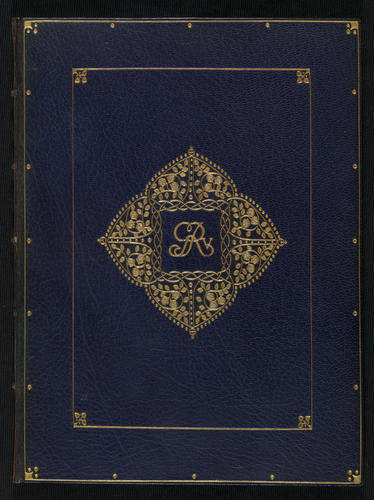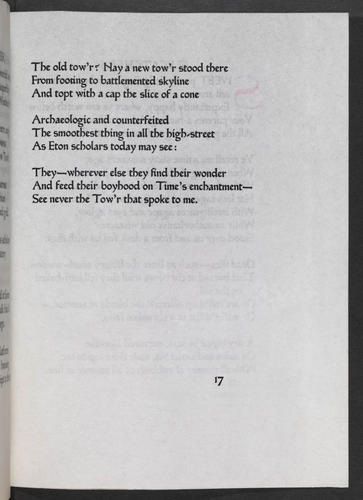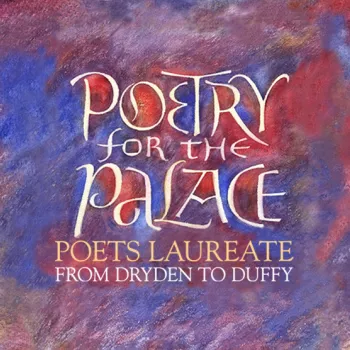Poems written in the year MCMXIII 1914
22 x 16.3 x 0.8 cm (book measurement (conservation)) | RCIN 1089585

Robert Seymour Bridges (1844-1930)
Poems written in the year MCMXIII / by Robert Bridges poet laureate 1914

Robert Seymour Bridges (1844-1930)
Poems written in the year MCMXIII / by Robert Bridges poet laureate 1914

Robert Seymour Bridges (1844-1930)
Poems written in the year MCMXIII / by Robert Bridges poet laureate 1914

Robert Seymour Bridges (1844-1930)
Poems written in the year MCMXIII / by Robert Bridges poet laureate 1914





-
Robert Seymour Bridges (1844–1930) was Poet Laureate of the United Kingdom from 1913 until his death in 1930. A medical doctor by profession, Bridges devoted himself to writing poetry after a lung condition forced him into early retirement. He was appointed to the Order of Merit in 1929.
This book contains a selection of Bridges’ poems written in the first year of his tenure as Poet Laureate. It was printed by the Ashendene Press, a private press established in 1895 by C.H. St John Hornby (1867–1946). One of only six copies printed on vellum leaves, it was was bound by W.H. Smith for presentation to King George V in blue goatskin with delicate gold tooling surrounding the cipher 'GRV'.
Further information
C.H. St John Hornby founded the Ashendene Press after an influential visit to William Morris’ Kelmscott Press in 1893 and a fruitful association with the Daniel Press at Oxford. It was named after, and initially housed at, Hornby’s family home in Hertfordshire, but moved to Chelsea in 1899. The selection of texts printed at Ashendene depended partly on Hornby's own literary taste, and on whether the books “gave scope for a certain gaiety of treatment in the use of coloured initials and chapter headings.”1
Poems Written in the Year MCMXIII is the only volume of Bridges' works published by Ashendene—but it was not the poet's first appearance in the private presses. The Daniel Press had printed Bridges' earlier poems between 1884 to 1903, and there is something of Charles Daniel's reserved typography here. The large Romanesque initial letters, printed here in alternating red and blue, were designed by the calligrapher Graily Hewitt (1864–1952). The type is Subiaco, a semi-gothic made especially for the Press by Edward Philip Prince (1846–1923), modelled on a type cut during the 1460s for Konrad Sweynheym and Arnold Pannartz, two German monks who operated the first printing press in Italy, at the Benedictine monastery of Subiaco. There are no running titles, and each page contains no more than twenty poetic lines. It is an easy and pleasurable read.Completed by December 1914, Poems was the final book printed by the Ashendene Press before the First World War. Although the Press would reopen in 1920, it is tempting to read Poems against this immediate background of conflict—indeed Bridges himself, presenting the volume to George V in 1915, stated that it contained “a sort of vaticination [prophesy] of the War”.2 Violence certainly looms over the Poems, whether we sense it obliquely in the “conquering shadow” of a total eclipse (‘The Philosopher and His Mistress’), or more directly in the demonic forces who “thrust their arms out over the world” (‘Hell and Hate’). While greater forces usually prevail—the eponymous demons of ‘Hell and Hate’ are consigned to “falling, falling away below / To the darkness out of sight”—what is left is ineluctable melancholia. Despite Bridges’ strong sense of religious faith, many of the poems deal with youth’s naivety, age’s decay, separation, and strife—
Footsteps of eternal Mind
On the path of the dead.3The moodiest of the poems is ‘The Curfew Tower’, written about the westernmost tower at Windsor Castle. The poet laments the renovations conducted in 1865, which stripped much of its medieval character and added a semi-conical roof modelled on the towers at Carcassonne in Southern France:
Archaeologic and counterfeited
The smoothest thing in all the high-street
As Eton scholars today may see:They—wherever else they find their wonder
And feed their boyhood on Time’s enchantment—
See never the Tow’r that spoke to me.This sense of an irretrievable past, of a lost enchantment, must have influenced Bridges in remarking that these poems were “truly descriptive” of the War. The bibliographer Colin Franklin, writing on the Ashendene Press in 1969, described Poems as “this last from the old world", and it is easy to see why.
References
[1] Quoted in Colin Franklin, The Private Presses, 2nd edition (Scolar Press, 1991), p. 52.
[2] [Presentation letter, Robert Bridges to Lord Stamfordham, 5th July 1915, typed copy], RCIN 1089585.b. Dated 5 July 1615.
[3] ‘October’, ll. 20-21.
Provenance
Presented to King George V by Robert Bridges, 5 July 1915
-
Creator(s)
Acquirer(s)
-
Measurements
22 x 16.3 x 0.8 cm (book measurement (conservation))
23.5 x 1.5 cm (book measurement (inventory))
Category
Alternative title(s)
Poems written in the year MCMXIII / by Robert Bridges poet laureate.








